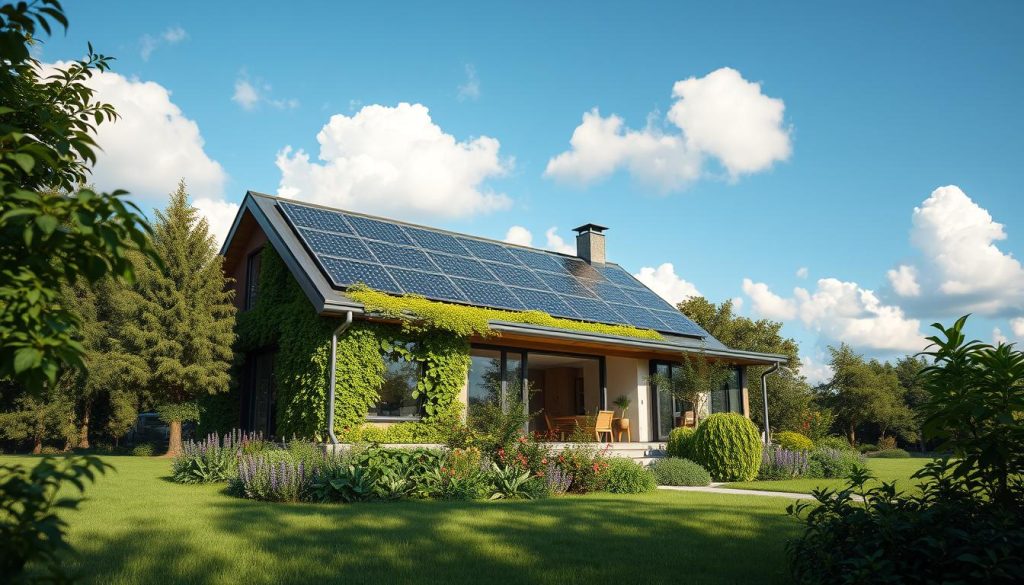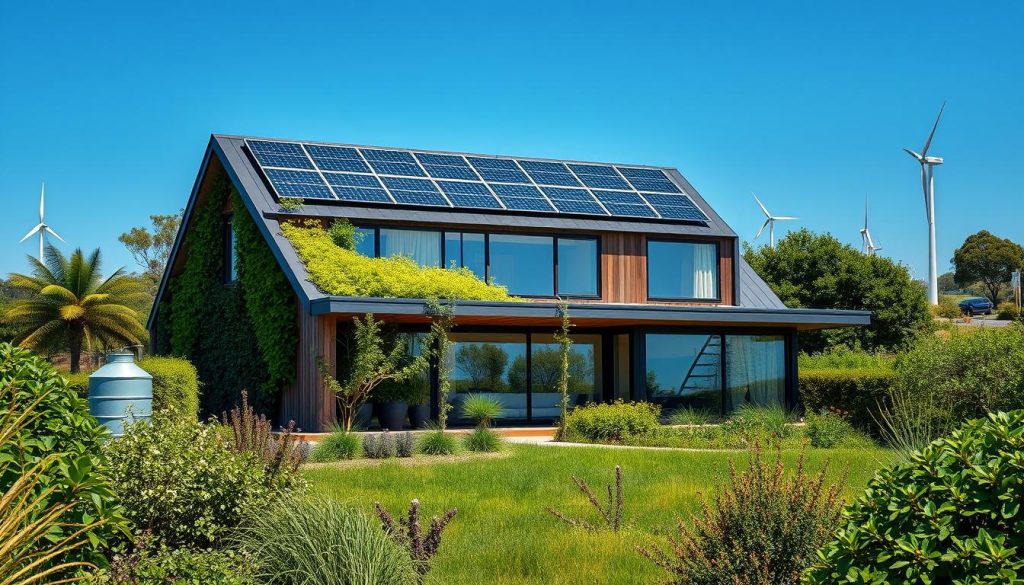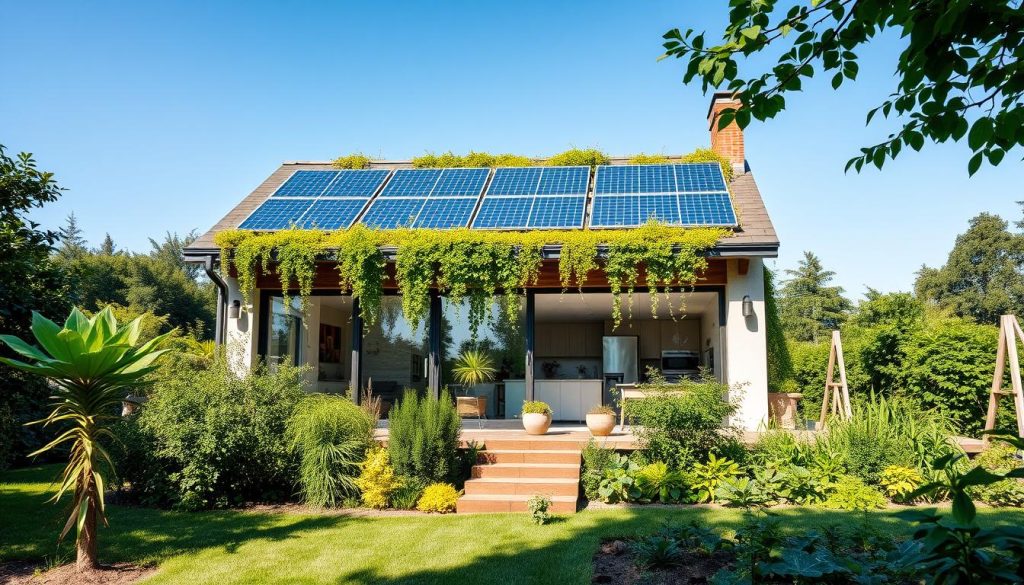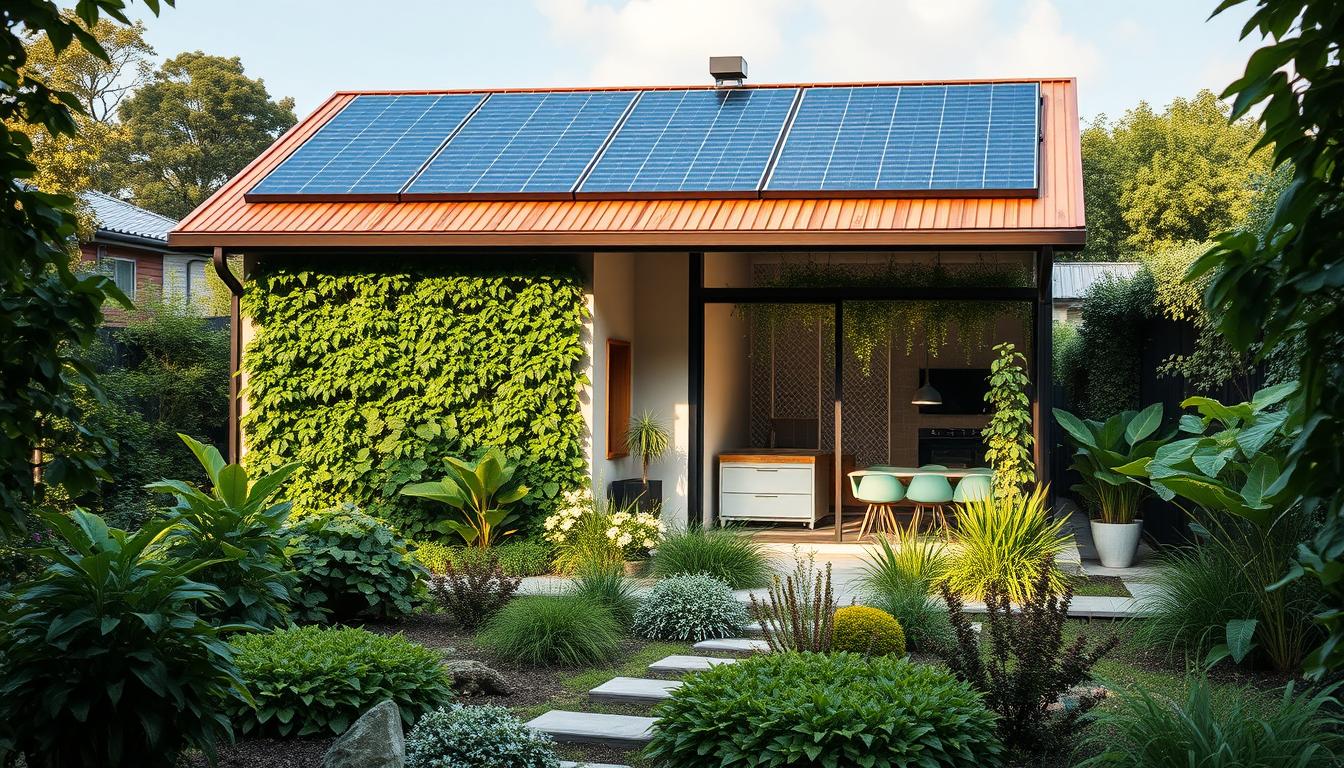Welcome to the future of living sustainably! Modern technology has made smart homes for sustainability a real possibility. These homes use advanced technology and eco-friendly practices to cut down on carbon emissions. They help us manage energy better, care for the environment, and enjoy the latest in home tech.
Starting our journey to sustainability is easy. We can make our homes smarter and greener one step at a time. Smart homes reduce energy waste and use renewable energy. Let’s see how smart homes can change our daily habits and help the planet.
Understanding Smart Homes and Their Impact on Sustainability
Smart homes are a big step towards living sustainably. They use advanced tech to make homes more efficient and convenient. These homes have systems and appliances that work together to save energy and encourage green living.
What is a Smart Home?
A smart home has automated systems for lighting, climate, entertainment, and appliances. The key is energy-efficient home automation, where devices talk to each other and adjust for best performance. Homeowners can control everything with a smartphone or tablet, making life easier and more efficient.
How Smart Technology Reduces Energy Consumption
Smart home tech is key to using less energy. Smart thermostats adjust the temperature based on who’s home and the time. Smart lights turn on only when needed, thanks to sensors or timers.
These devices not only save energy but also lower utility bills. They make homes more environmentally friendly.
The Role of Smart Homes in Climate Change
Widespread use of smart homes could greatly help fight climate change. Energy-efficient home automation cuts down on carbon emissions. For example, smart energy systems with solar panels use and store solar energy better, reducing reliance on fossil fuels.
Smart home tech is more than just convenience. It’s about making choices that help the planet. As more people embrace smart homes, we can work towards a greener future.
| Device | Function | Environmental Impact |
|---|---|---|
| Smart Thermostats | Automate heating and cooling | Reduces unnecessary energy use |
| Smart Lighting | Sensors and timers control lighting | Decreases electricity consumption |
| Energy Monitoring Systems | Monitor and optimize energy use | Lowers overall carbon footprint |
| Smart Appliances | Energy-efficient operation | Conserves resources |
Benefits of Implementing Smart Technologies
Smart home technologies bring many benefits, making our homes more sustainable. They improve our daily lives and help the environment. Let’s explore some key advantages of these technologies.
Improved Energy Efficiency
Smart homes use less energy thanks to smart heating and cooling systems. For example, the Nest Learning Thermostat adjusts the temperature based on your schedule. This saves energy.
Programmable appliances also help by running during off-peak hours. This approach is key to making our homes more sustainable.
Enhanced Water Conservation
Smart technologies also help save water. Smart irrigation systems use weather data to water plants perfectly. This prevents wasting water.
Smart leak detectors and valves catch leaks early. This lets homeowners fix problems quickly, saving water. These tools are crucial for a water-wise home.
Increased Convenience and Comfort
Smart home tech also makes life easier and more comfortable. Features like Amazon Alexa and smart lighting systems make daily tasks simpler. They let you control your home with just a voice or a tap on your phone.
This convenience, combined with being eco-friendly, makes smart homes ideal for sustainability. It’s a win-win for both comfort and the planet.
Top Smart Home Devices for Sustainable Living

Building an eco-friendly smart home helps our planet. The right tech can cut down energy use and save resources. Here are key devices for a green smart home.
Smart Thermostats
Smart thermostats change how we heat and cool our homes. They learn our habits and adjust the temperature. Brands like Ecobee and Nest lead in making these devices.
These thermostats save energy and money. They also cut down on carbon emissions. So, they’re great for living sustainably.
Energy Monitoring Systems
Energy monitoring systems help us watch our energy use. They show how much electricity we use in real time. This lets us find ways to use less.
Systems from Sense and Emporia Vue give detailed energy use data. This helps us make our homes more eco-friendly. It’s a step towards a greener home.
Eco-Friendly Smart Lighting
Lighting is a big part of energy use. Eco-friendly smart lighting uses LED bulbs and smart controls to save energy. Brands like Philips Hue and LIFX offer smart lighting.
These lights use timers, sensors, and remote controls. They last longer and use less power. This supports a green home.
| Device | Brand | Key Features | Energy Efficiency Impact |
|---|---|---|---|
| Smart Thermostat | Ecobee | Voice control, remote sensors | Optimizes heating/cooling schedules |
| Energy Monitor | Sense | Real-time energy usage insights | Identifies energy drains |
| Smart Lighting | Philips Hue | LED bulbs, color control | Reduces power consumption |
My Journey to a Sustainable Smart Home

Starting my journey to a green smart home was thrilling and educational. I aimed to make a space that fit my lifestyle and was good for the planet. I planned carefully and made smart choices to turn every room into an energy-saving haven. Here’s how it all came together.
Setting Up My Energy-Efficient Appliances
I began by picking the right appliances. I got a Nest Learning Thermostat for my HVAC, which learned my habits and saved energy. My fridge is now an Energy Star model from Samsung, cutting energy use by almost 30%. I also used smart plugs and power strips to control devices like my coffee maker and TV, saving energy when not in use.
Tracking My Usage and Impact
Knowing my home’s energy use was key to seeing my progress. I set up an energy monitoring system to track my electricity use. This tool showed me where I could save more. I saw big drops in my energy bills and a smaller carbon footprint, proving the value of energy-saving tech.
| Appliance | Energy Savings |
|---|---|
| HVAC with Thermostat | 20% |
| Energy Star Fridge | 30% |
| Smart Plugs | 10% |
Adjusting Habits for Eco-Friendly Living
Adopting a sustainable lifestyle meant changing my daily habits. I started turning off lights and electronics when not needed. Meal prep helped me use kitchen appliances wisely, and setting my thermostat for away modes saved energy. These habits, along with my green smart home, have greatly reduced my environmental impact.
Overcoming Challenges in Smart Home Adoption

Choosing a smart home for sustainability is a smart move, but it faces unique challenges. Costs, learning new tech, and privacy worries are big hurdles. They need careful thought and planning to overcome.
Initial Investment Cost Considerations
The high upfront cost is a big barrier. Smart devices like thermostats and lights can be expensive. But, remember, they save money and help the planet in the long run.
Learning Curve with New Technologies
Getting a smart home can be tough, especially for tech newbies. It takes time to learn how to use and keep these devices running. Good tutorials and easy-to-use systems can help a lot.
Addressing Privacy and Security Concerns
Privacy and security are key when using smart home tech. Fears of data breaches and unauthorized access can stop people from going smart. Using secure devices and keeping software up to date helps. Knowing how your devices handle your data also gives peace of mind.
Here’s a look at common challenges and how to solve them for smart home adoption:
| Challenge | Solution |
|---|---|
| High Initial Costs | Consider long-term savings; look for financial incentives. |
| Learning Curve | Access tutorials and seek customer support. |
| Privacy Concerns | Use secure devices, understand privacy policies, and update regularly. |
Future Trends in Smart Home Sustainability
The future of sustainable living technology is exciting. It’s bringing new ways to make our homes smarter and greener. Energy management is a big area where AI and machine learning are changing the game.
Innovations in Energy Management
New tech in energy management is making our lives better and more eco-friendly. AI and machine learning help smart systems predict energy use. This means they can use less and waste less, making our homes more sustainable.
The Rise of Renewable Energy Integration
Renewable energy is becoming a big part of smart homes. Solar panels and battery systems are getting easier to use. They let homeowners use and save energy from the sun. This cuts down on fossil fuel use and makes energy more reliable.
The Community Impact of Smart Homes
Smart homes can do more than just help individual families. They can also help whole communities. By sharing data and resources, smart homes can lead to bigger, eco-friendly efforts. This can make a big difference for the environment, beyond just one home.

